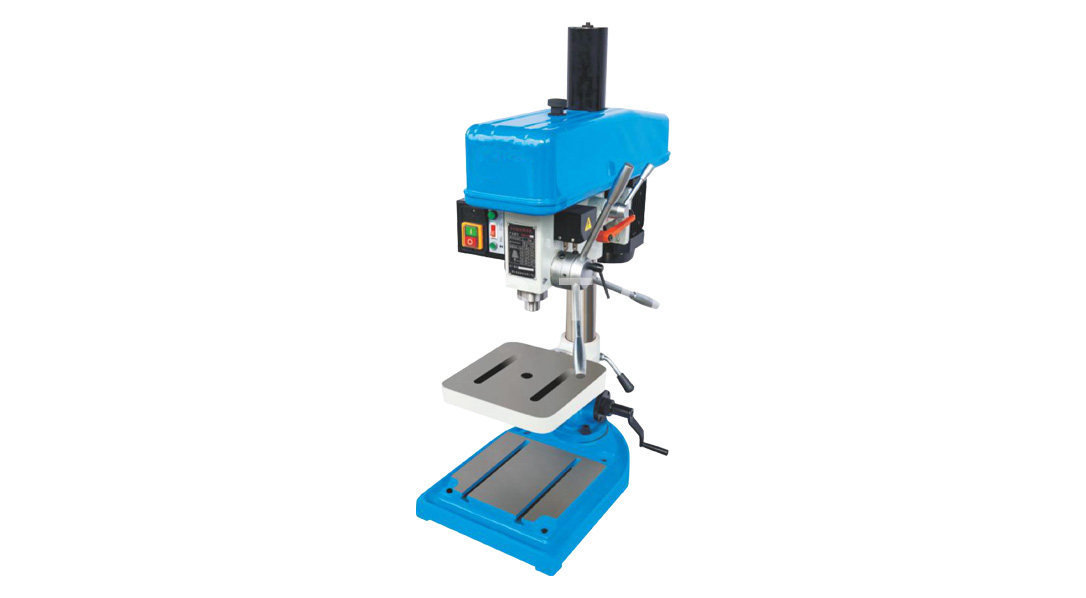Drilling machine refers to a machine tool that mainly uses a drill bit to machine holes in a workpiece.

Usually the drill bit rotates for the main motion and the drill bit moves axially for the feed motion.
The drilling machine has a simple structure and relatively low machining precision. It can drill through holes and blind holes. After replacing special tools, it’s able to enlarge, boring, reaming or tapping.
During the machining process, the workpiece does not move, the tool moves. The tool center is aligned with the center of the hole, and the tool is rotated (main motion).
The characteristics of the drilling machine are that the workpiece is fixed and the tool is rotated.
A Brief History
In the early 1970s, drilling machines were still controlled by ordinary relays in the world.
For example, MEGA50 of ELDORADO Company of the United States entering the China’s market from the 1970s to the 1980s, T30-3-250 of TBT Company of Germany, B4-H30-C/L of NAGEL Company, and DEG type drilling machines of Japan Kanzaki Advanced Seiko Co., Ltd. are all controlled by relays.
In the late 1980s, due to the emergence of numerical control technology, it was gradually applied in deep hole drilling machines, especially after 90 years.
For example, TBT’s ML series deep hole drilling machine feed system, which was launched in the early 1990s, was changed from a mechanical continuously variable transmission to an AC servo motor to drive a ball screw pair.
The feed slide rail adopts a rolling linear guide.
In order to ensure high-speed rotation and high precision, the drill rod box transmission is driven by the exchange pulley and the belt, and the two-speed motor driven stepless transmission becomes the stepless speed-regulated inverter motor to the electric spindle drive, which creates favorable conditions for deep hole drilling machine which is used for drilling small hole and Improving the horizontal quality.
In order to process the intersections or arbitrary angles on certain parts, or oblique holes, vertical holes or parallel holes at a certain angle to the center line of the machined parts, various special deep hole drilling machines have been specially developed in various countries.
For example, it is specially designed for machining oil holes on the crankshaft, inclined oil holes on the connecting rod, parallel holes and a plurality of radial discharge holes of the feed mechanical feeding die.
It is especially suitable for BW250-KW deep hole drilling machines for crankshaft oil holes of medium and large trucks. They all have X, Y, Z and W axis which are controlled by CNC.
In order to meet the needs of customers, a variety of different types of crankshaft oil holes can be processed in one production line. In 2000, the first flexible crankshaft machining center was designed and manufactured to process all oil holes on different crankshafts of 2-12 cylinders.
A special deep hole drilling machine developed by MOLLART for the processing of pellet extrusion dies with six spindles simultaneously machining six holes on the same workpiece.
The number of workpiece holes is up to 36,000, all controlled by the CNC system.
The actual role of the drilling machine
Drilling machines are versatile machine tools for a wide range of applications, such as drilling, enlarging, reaming, boring and tapping.
When the drilling machine is equipped with process equipment, it can also be boring.
Drilling, enlarging, and reaming can also be performed on the drill table with a universal workbench.
Copyright © Jiangsu Hoston Machine Tools Co., Ltd. (Hongkong Hoston Group CO., LIMITED)All Rights Reserved | Sitemap Technical Support: 